Konstantinos Kallidromitis
LaViDa: A Large Diffusion Language Model for Multimodal Understanding
May 22, 2025Abstract:Modern Vision-Language Models (VLMs) can solve a wide range of tasks requiring visual reasoning. In real-world scenarios, desirable properties for VLMs include fast inference and controllable generation (e.g., constraining outputs to adhere to a desired format). However, existing autoregressive (AR) VLMs like LLaVA struggle in these aspects. Discrete diffusion models (DMs) offer a promising alternative, enabling parallel decoding for faster inference and bidirectional context for controllable generation through text-infilling. While effective in language-only settings, DMs' potential for multimodal tasks is underexplored. We introduce LaViDa, a family of VLMs built on DMs. We build LaViDa by equipping DMs with a vision encoder and jointly fine-tune the combined parts for multimodal instruction following. To address challenges encountered, LaViDa incorporates novel techniques such as complementary masking for effective training, prefix KV cache for efficient inference, and timestep shifting for high-quality sampling. Experiments show that LaViDa achieves competitive or superior performance to AR VLMs on multi-modal benchmarks such as MMMU, while offering unique advantages of DMs, including flexible speed-quality tradeoff, controllability, and bidirectional reasoning. On COCO captioning, LaViDa surpasses Open-LLaVa-Next-8B by +4.1 CIDEr with 1.92x speedup. On bidirectional tasks, it achieves +59% improvement on Constrained Poem Completion. These results demonstrate LaViDa as a strong alternative to AR VLMs. Code and models will be released in the camera-ready version.
Reflect-DiT: Inference-Time Scaling for Text-to-Image Diffusion Transformers via In-Context Reflection
Mar 15, 2025Abstract:The predominant approach to advancing text-to-image generation has been training-time scaling, where larger models are trained on more data using greater computational resources. While effective, this approach is computationally expensive, leading to growing interest in inference-time scaling to improve performance. Currently, inference-time scaling for text-to-image diffusion models is largely limited to best-of-N sampling, where multiple images are generated per prompt and a selection model chooses the best output. Inspired by the recent success of reasoning models like DeepSeek-R1 in the language domain, we introduce an alternative to naive best-of-N sampling by equipping text-to-image Diffusion Transformers with in-context reflection capabilities. We propose Reflect-DiT, a method that enables Diffusion Transformers to refine their generations using in-context examples of previously generated images alongside textual feedback describing necessary improvements. Instead of passively relying on random sampling and hoping for a better result in a future generation, Reflect-DiT explicitly tailors its generations to address specific aspects requiring enhancement. Experimental results demonstrate that Reflect-DiT improves performance on the GenEval benchmark (+0.19) using SANA-1.0-1.6B as a base model. Additionally, it achieves a new state-of-the-art score of 0.81 on GenEval while generating only 20 samples per prompt, surpassing the previous best score of 0.80, which was obtained using a significantly larger model (SANA-1.5-4.8B) with 2048 samples under the best-of-N approach.
OmniFlow: Any-to-Any Generation with Multi-Modal Rectified Flows
Dec 02, 2024



Abstract:We introduce OmniFlow, a novel generative model designed for any-to-any generation tasks such as text-to-image, text-to-audio, and audio-to-image synthesis. OmniFlow advances the rectified flow (RF) framework used in text-to-image models to handle the joint distribution of multiple modalities. It outperforms previous any-to-any models on a wide range of tasks, such as text-to-image and text-to-audio synthesis. Our work offers three key contributions: First, we extend RF to a multi-modal setting and introduce a novel guidance mechanism, enabling users to flexibly control the alignment between different modalities in the generated outputs. Second, we propose a novel architecture that extends the text-to-image MMDiT architecture of Stable Diffusion 3 and enables audio and text generation. The extended modules can be efficiently pretrained individually and merged with the vanilla text-to-image MMDiT for fine-tuning. Lastly, we conduct a comprehensive study on the design choices of rectified flow transformers for large-scale audio and text generation, providing valuable insights into optimizing performance across diverse modalities. The Code will be available at https://github.com/jacklishufan/OmniFlows.
SegLLM: Multi-round Reasoning Segmentation
Oct 24, 2024



Abstract:We present SegLLM, a novel multi-round interactive reasoning segmentation model that enhances LLM-based segmentation by exploiting conversational memory of both visual and textual outputs. By leveraging a mask-aware multimodal LLM, SegLLM re-integrates previous segmentation results into its input stream, enabling it to reason about complex user intentions and segment objects in relation to previously identified entities, including positional, interactional, and hierarchical relationships, across multiple interactions. This capability allows SegLLM to respond to visual and text queries in a chat-like manner. Evaluated on the newly curated MRSeg benchmark, SegLLM outperforms existing methods in multi-round interactive reasoning segmentation by over 20%. Additionally, we observed that training on multi-round reasoning segmentation data enhances performance on standard single-round referring segmentation and localization tasks, resulting in a 5.5% increase in cIoU for referring expression segmentation and a 4.5% improvement in Acc@0.5 for referring expression localization.
Hyperbolic Learning with Multimodal Large Language Models
Aug 09, 2024Abstract:Hyperbolic embeddings have demonstrated their effectiveness in capturing measures of uncertainty and hierarchical relationships across various deep-learning tasks, including image segmentation and active learning. However, their application in modern vision-language models (VLMs) has been limited. A notable exception is MERU, which leverages the hierarchical properties of hyperbolic space in the CLIP ViT-large model, consisting of hundreds of millions parameters. In our work, we address the challenges of scaling multi-modal hyperbolic models by orders of magnitude in terms of parameters (billions) and training complexity using the BLIP-2 architecture. Although hyperbolic embeddings offer potential insights into uncertainty not present in Euclidean embeddings, our analysis reveals that scaling these models is particularly difficult. We propose a novel training strategy for a hyperbolic version of BLIP-2, which allows to achieve comparable performance to its Euclidean counterpart, while maintaining stability throughout the training process and showing a meaningful indication of uncertainty with each embedding.
Aligning Diffusion Models by Optimizing Human Utility
Apr 06, 2024Abstract:We present Diffusion-KTO, a novel approach for aligning text-to-image diffusion models by formulating the alignment objective as the maximization of expected human utility. Since this objective applies to each generation independently, Diffusion-KTO does not require collecting costly pairwise preference data nor training a complex reward model. Instead, our objective requires simple per-image binary feedback signals, e.g. likes or dislikes, which are abundantly available. After fine-tuning using Diffusion-KTO, text-to-image diffusion models exhibit superior performance compared to existing techniques, including supervised fine-tuning and Diffusion-DPO, both in terms of human judgment and automatic evaluation metrics such as PickScore and ImageReward. Overall, Diffusion-KTO unlocks the potential of leveraging readily available per-image binary signals and broadens the applicability of aligning text-to-image diffusion models with human preferences.
Hierarchical Open-vocabulary Universal Image Segmentation
Jul 03, 2023Abstract:Open-vocabulary image segmentation aims to partition an image into semantic regions according to arbitrary text descriptions. However, complex visual scenes can be naturally decomposed into simpler parts and abstracted at multiple levels of granularity, introducing inherent segmentation ambiguity. Unlike existing methods that typically sidestep this ambiguity and treat it as an external factor, our approach actively incorporates a hierarchical representation encompassing different semantic-levels into the learning process. We propose a decoupled text-image fusion mechanism and representation learning modules for both "things" and "stuff".1 Additionally, we systematically examine the differences that exist in the textual and visual features between these types of categories. Our resulting model, named HIPIE, tackles HIerarchical, oPen-vocabulary, and unIvErsal segmentation tasks within a unified framework. Benchmarked on over 40 datasets, e.g., ADE20K, COCO, Pascal-VOC Part, RefCOCO/RefCOCOg, ODinW and SeginW, HIPIE achieves the state-of-the-art results at various levels of image comprehension, including semantic-level (e.g., semantic segmentation), instance-level (e.g., panoptic/referring segmentation and object detection), as well as part-level (e.g., part/subpart segmentation) tasks. Our code is released at https://github.com/berkeley-hipie/HIPIE.
Hyperbolic Active Learning for Semantic Segmentation under Domain Shift
Jun 26, 2023Abstract:For the task of semantic segmentation (SS) under domain shift, active learning (AL) acquisition strategies based on image regions and pseudo labels are state-of-the-art (SoA). The presence of diverse pseudo-labels within a region identifies pixels between different classes, which is a labeling efficient active learning data acquisition strategy. However, by design, pseudo-label variations are limited to only select the contours of classes, limiting the final AL performance. We approach AL for SS in the Poincar\'e hyperbolic ball model for the first time and leverage the variations of the radii of pixel embeddings within regions as a novel data acquisition strategy. This stems from a novel geometric property of a hyperbolic space trained without enforced hierarchies, which we experimentally prove. Namely, classes are mapped into compact hyperbolic areas with a comparable intra-class radii variance, as the model places classes of increasing explainable difficulty at denser hyperbolic areas, i.e. closer to the Poincar\'e ball edge. The variation of pixel embedding radii identifies well the class contours, but they also select a few intra-class peculiar details, which boosts the final performance. Our proposed HALO (Hyperbolic Active Learning Optimization) surpasses the supervised learning performance for the first time in AL for SS under domain shift, by only using a small portion of labels (i.e., 1%). The extensive experimental analysis is based on two established benchmarks, i.e. GTAV $\rightarrow$ Cityscapes and SYNTHIA $\rightarrow$ Cityscapes, where we set a new SoA. The code will be released.
Refine and Represent: Region-to-Object Representation Learning
Aug 25, 2022
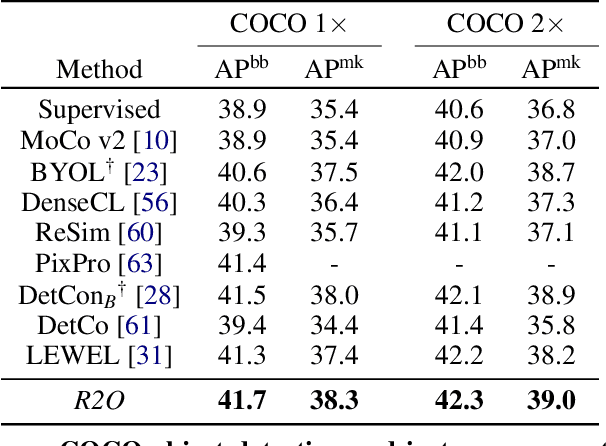
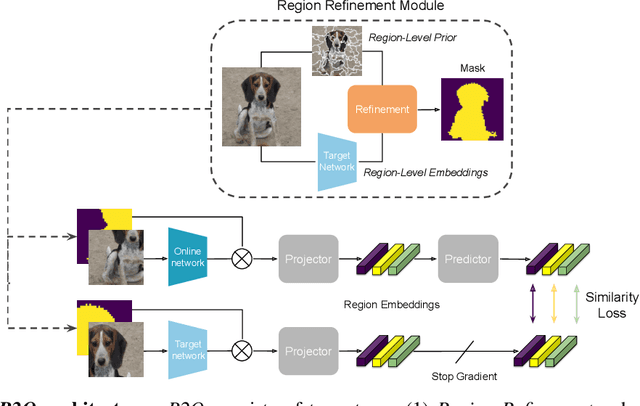
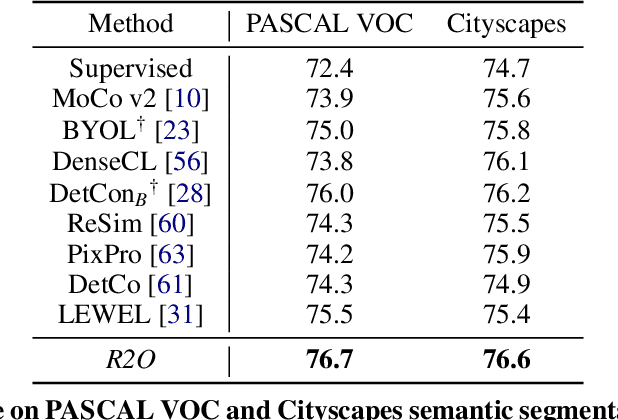
Abstract:Recent works in self-supervised learning have demonstrated strong performance on scene-level dense prediction tasks by pretraining with object-centric or region-based correspondence objectives. In this paper, we present Region-to-Object Representation Learning (R2O) which unifies region-based and object-centric pretraining. R2O operates by training an encoder to dynamically refine region-based segments into object-centric masks and then jointly learns representations of the contents within the mask. R2O uses a "region refinement module" to group small image regions, generated using a region-level prior, into larger regions which tend to correspond to objects by clustering region-level features. As pretraining progresses, R2O follows a region-to-object curriculum which encourages learning region-level features early on and gradually progresses to train object-centric representations. Representations learned using R2O lead to state-of-the art performance in semantic segmentation for PASCAL VOC (+0.7 mIOU) and Cityscapes (+0.4 mIOU) and instance segmentation on MS COCO (+0.3 mask AP). Further, after pretraining on ImageNet, R2O pretrained models are able to surpass existing state-of-the-art in unsupervised object segmentation on the Caltech-UCSD Birds 200-2011 dataset (+2.9 mIoU) without any further training. We provide the code/models from this work at https://github.com/KKallidromitis/r2o.
Contrastive Neural Processes for Self-Supervised Learning
Oct 31, 2021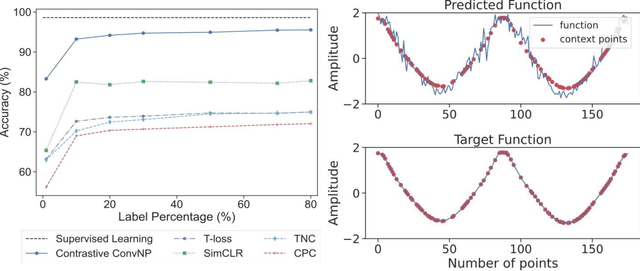

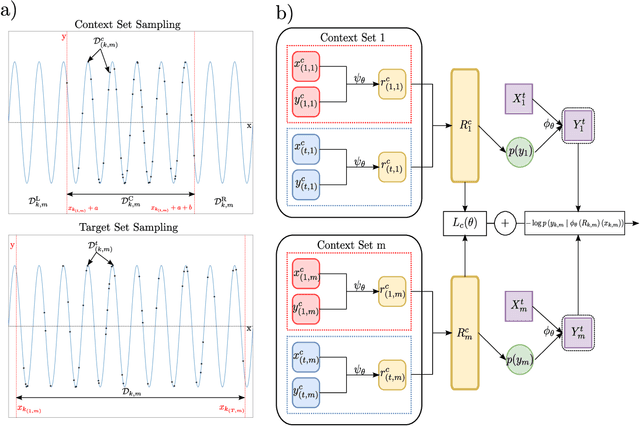

Abstract:Recent contrastive methods show significant improvement in self-supervised learning in several domains. In particular, contrastive methods are most effective where data augmentation can be easily constructed e.g. in computer vision. However, they are less successful in domains without established data transformations such as time series data. In this paper, we propose a novel self-supervised learning framework that combines contrastive learning with neural processes. It relies on recent advances in neural processes to perform time series forecasting. This allows to generate augmented versions of data by employing a set of various sampling functions and, hence, avoid manually designed augmentations. We extend conventional neural processes and propose a new contrastive loss to learn times series representations in a self-supervised setup. Therefore, unlike previous self-supervised methods, our augmentation pipeline is task-agnostic, enabling our method to perform well across various applications. In particular, a ResNet with a linear classifier trained using our approach is able to outperform state-of-the-art techniques across industrial, medical and audio datasets improving accuracy over 10% in ECG periodic data. We further demonstrate that our self-supervised representations are more efficient in the latent space, improving multiple clustering indexes and that fine-tuning our method on 10% of labels achieves results competitive to fully-supervised learning.
 Add to Chrome
Add to Chrome Add to Firefox
Add to Firefox Add to Edge
Add to Edge